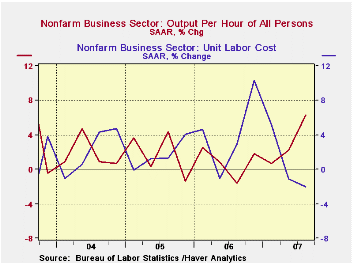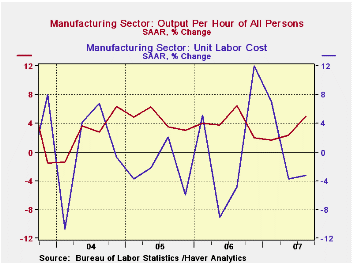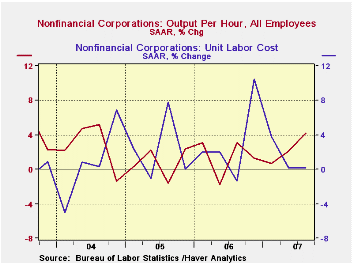 Global| Dec 05 2007
Global| Dec 05 2007Q3 Productivity Revised Up, Unit Labor Costs Revised Down
by:Tom Moeller
|in:Economy in Brief
Summary
Due mostly to an upward revision in output, nonfarm labor productivity growth last quarter was revised up to 6.3% from 4.9%. The revised gain matched Consensus estimates and it was the quickest quarterly rise in four years. The [...]

Due mostly to an upward revision in output, nonfarm labor productivity growth last quarter was revised up to 6.3% from 4.9%. The revised gain matched Consensus estimates and it was the quickest quarterly rise in four years.
The largest factor behind the revision came from output growth to 5.7% from the preliminary 4.3%. More output from fewer hours worked. Hours worked were revised little and now are estimated to have fallen 0.6%, the largest quarterly drop in over four years.
Revised in the opposite direction, compensation per hour last quarter was taken down to 4.2%. Despite that revision, as well as a deceleration in compensation growth from outsized gains during 1Q & 4Q '06, the annual gain in compensation of 5.8% was its quickest since 2000.
 Productivity in the factory sector also was revised up, but to a lesser extent, to 5.0% from a preliminary 4.6% gain. It was double the 2Q increase and it still owed to a slight decline in hours worked accompanied by a swift 4.5% gain in output. Compensation growth in the factory sector made up for a 2Q decline with a 1.5% rise. That left the y/y gain stable at 5.6%, its fastest since early 2005. Unit labor costs in the factory sector fell a revised 3.3%, about as they did in the initial report. The annual increase was lowered a bit 2.8%, still the quickest since late 2000.
Productivity in the factory sector also was revised up, but to a lesser extent, to 5.0% from a preliminary 4.6% gain. It was double the 2Q increase and it still owed to a slight decline in hours worked accompanied by a swift 4.5% gain in output. Compensation growth in the factory sector made up for a 2Q decline with a 1.5% rise. That left the y/y gain stable at 5.6%, its fastest since early 2005. Unit labor costs in the factory sector fell a revised 3.3%, about as they did in the initial report. The annual increase was lowered a bit 2.8%, still the quickest since late 2000.
How well do wages follow productivity growth? from the Federal Reserve Bank of St. Louis can be found here.
| Non-farm Business Sector (SAAR) | Q3 '07 Revised | Q3 '07 Prelim. | Q2 '07 | Y/Y | 2006 | 2005 | 2004 |
|---|---|---|---|---|---|---|---|
| Output per Hour | 6.3% | 4.9% | 2.2% | 2.7% | 1.0% | 1.9% | 2.7% |
| Compensation per Hour | 4.2% | 4.7% | 4.4% | 5.8% | 3.9% | 4.0% | 3.6% |
| Unit Labor Costs | -2.0% | -0.2% | 2.2% | 3.0% | 2.9% | 2.0% | 0.9% |
Tom Moeller
AuthorMore in Author Profile »Prior to joining Haver Analytics in 2000, Mr. Moeller worked as the Economist at Chancellor Capital Management from 1985 to 1999. There, he developed comprehensive economic forecasts and interpreted economic data for equity and fixed income portfolio managers. Also at Chancellor, Mr. Moeller worked as an equity analyst and was responsible for researching and rating companies in the economically sensitive automobile and housing industries for investment in Chancellor’s equity portfolio. Prior to joining Chancellor, Mr. Moeller was an Economist at Citibank from 1979 to 1984. He also analyzed pricing behavior in the metals industry for the Council on Wage and Price Stability in Washington, D.C. In 1999, Mr. Moeller received the award for most accurate forecast from the Forecasters' Club of New York. From 1990 to 1992 he was President of the New York Association for Business Economists. Mr. Moeller earned an M.B.A. in Finance from Fordham University, where he graduated in 1987. He holds a Bachelor of Arts in Economics from George Washington University.






